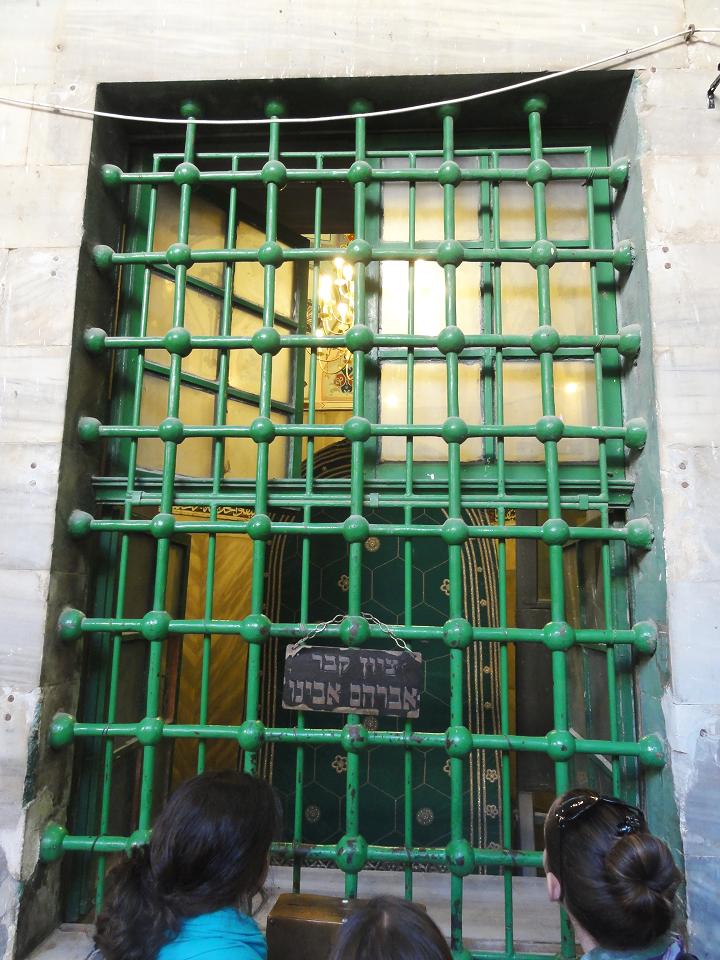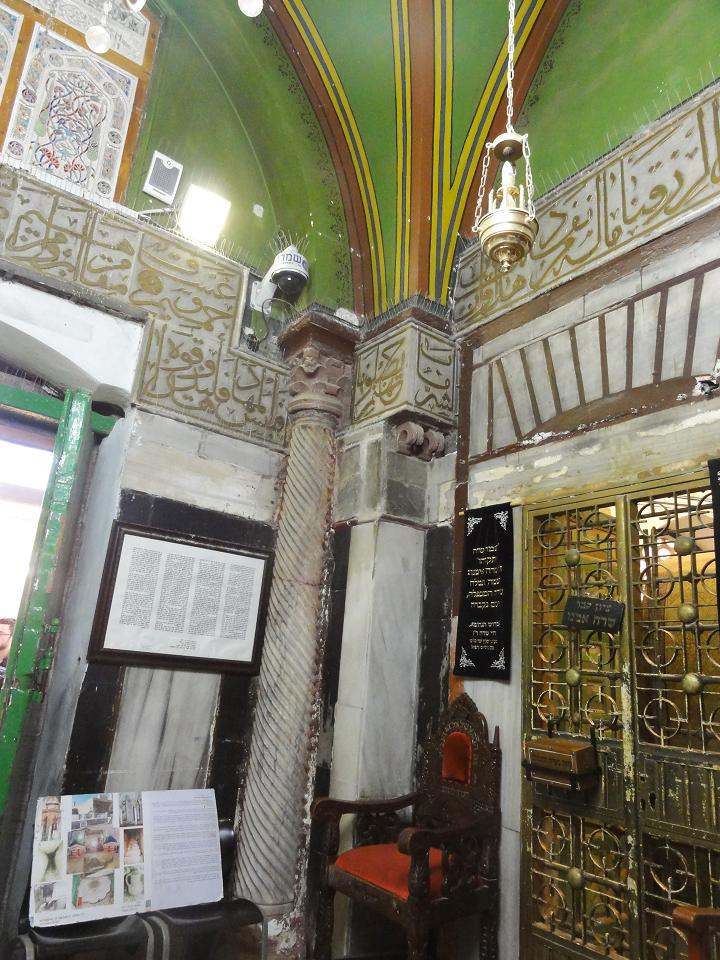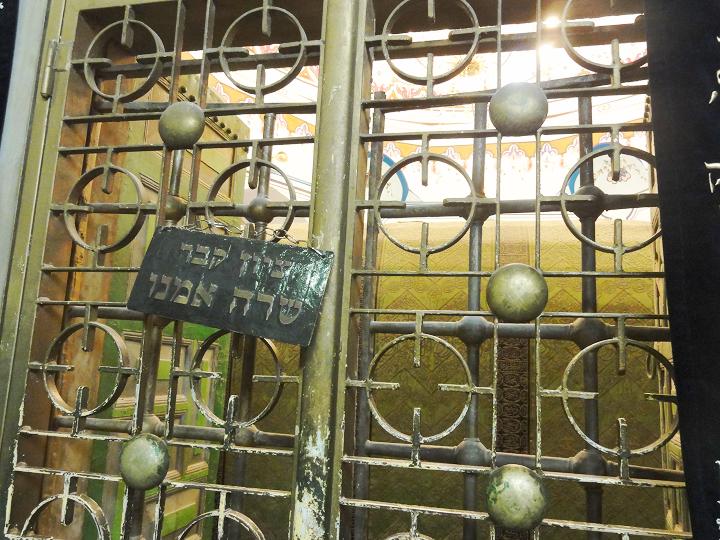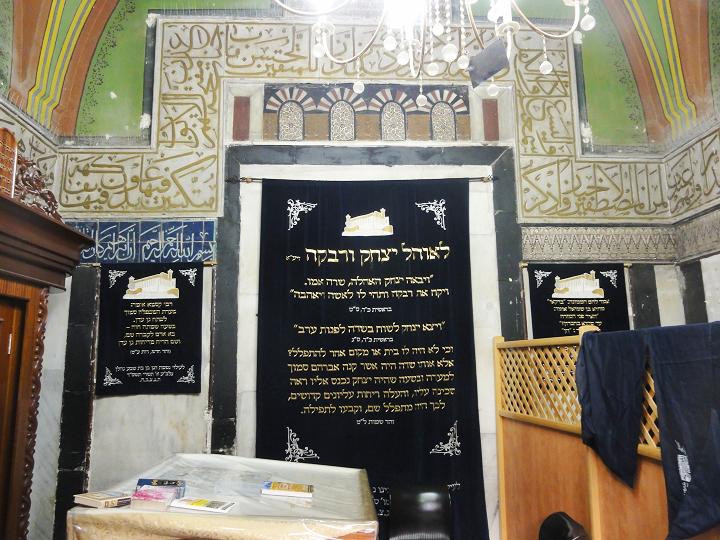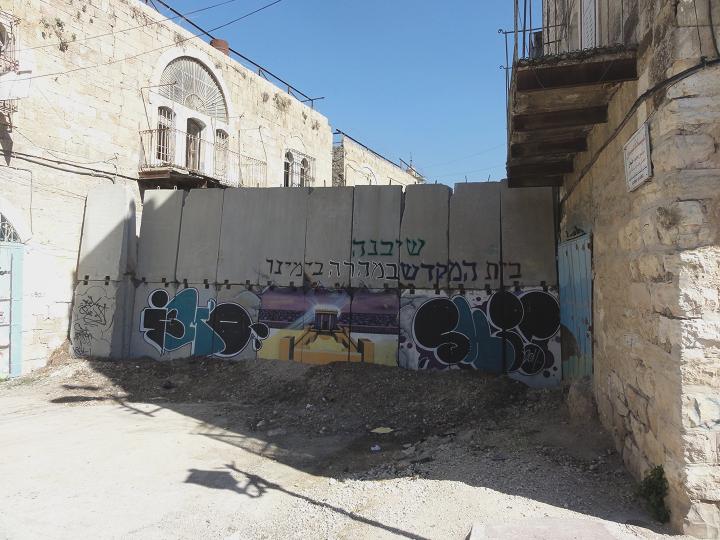Hebron is one of the Holiest ancient cities in the Holy Land, and the place of the burial cave of Patriarchs and Matriarchs.
* Site of the Month Aug 2014 *
Home > Sites> Judea> South > Hebron
Contents:
Background
Location
History
Photos
* Tomb of Patriarchs
* Beit Hadassah
* Avraham Avinu
* Tel Hebron
* City views
* David’s pool
Etymology
Links
Overview:
Hebron is one of the Holiest ancient cities in the Holy Land, and the site of the nation’s roots and origins. It was the city where King David ruled for seven and a half years before moving to Jerusalem, and the place of the cave of Patriarchs – Abraham, Isaac and Jacob – and the Matriarchs – Sarah, Rebecca and Leah.
2 Samuel 2:11: “And the time that David was king in Hebron over the house of Judah”.
Location and Aerial map:
Hebron is the highest Biblical cities, sitting at an approximate height of 900m (3,000 feet). It is located 32 KM (20 miles) southwest of Jerusalem.
The aerial view shows the points of interest in the center of Hebron.
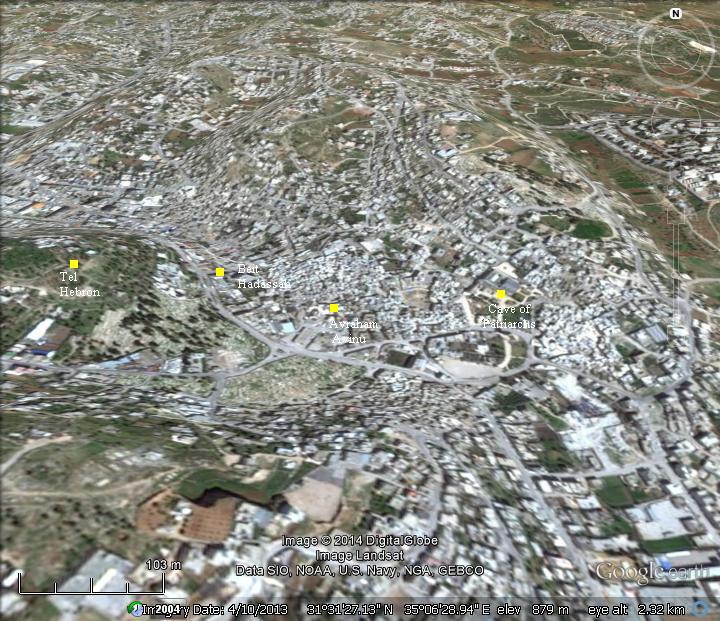
History of the place:
-
Late Bronze Age (1550 – 1200 B.C.) – Canaanites and the Patriarchs
Abraham came to the area of Hebron and set up his tent, and the Lord appeared to him for the first time, giving his people the Land of Canaan (Genesis 13:18): “Then Abram removed his tent, and came and dwelt in the plain of Mamre, which is in Hebron, and built there an altar unto the LORD”.
Later, Abraham buried his wife Sarah in a burial cave in Hebron, also known as Kiriath Arba (Genesis 23 1-2): “And Sarah was an hundred and seven and twenty years old: these were the years of the life of Sarah. And Sarah died in Kirjatharba; the same is Hebron in the land of Canaan: and Abraham came to mourn for Sarah, and to weep for her”.
Abraham purchases the cave from Ephron the Hittite, who owned the field where the cave was located, as a family burial place. (Genesis 23 2-9) : “And Abraham stood up from before his dead, and spake unto the sons of Heth, saying, I am a stranger and a sojourner with you: give me a possession of a burying place with you, that I may bury my dead out of my sight.
And the children of Heth answered Abraham, saying unto him, Hear us, my lord: thou art a mighty prince among us: in the choice of our sepulchres bury thy dead; none of us shall withhold from thee his sepulchre, but that thou mayest bury thy dead. And Abraham stood up, and bowed himself to the people of the land, even to the children of Heth. And he communed with them, saying, If it be your mind that I should bury my dead out of my sight; hear me, and entreat for me to Ephron the son of Zohar, That he may give me the cave of Machpelah, which he hath, which is in the end of his field; for as much money as it is worth he shall give it me for a possession of a burying place amongst you.
Abraham pays 400 shekels of silver for the place (Genesis 23 14-20):
“And Ephron answered Abraham, saying unto him, My lord, hearken unto me: the land is worth four hundred shekels of silver; what is that betwixt me and thee? bury therefore thy dead. And Abraham hearkened unto Ephron; and Abraham weighed to Ephron the silver, which he had named in the audience of the sons of Heth, four hundred shekels of silver, current money with the merchant. And the field of Ephron which was in Machpelah, which was before Mamre, the field, and the cave which was therein, and all the trees that were in the field, that were in all the borders round about, were made sure Unto Abraham for a possession in the presence of the children of Heth, before all that went in at the gate of his city. And after this, Abraham buried Sarah his wife in the cave of the field of Machpelah before Mamre: the same is Hebron in the land of Canaan. And the field, and the cave that is therein, were made sure unto Abraham for a possession of a burying place by the sons of Heth”.
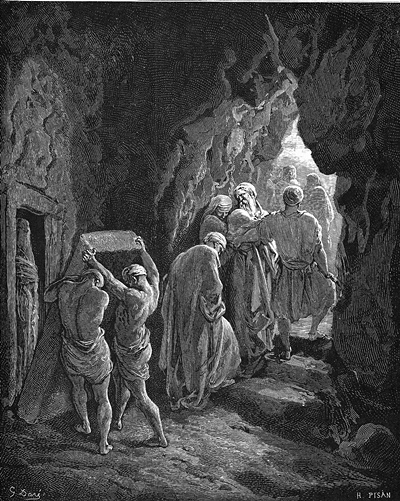
Burial of Sarah by Abraham
– Illustration by Gustav Dore (French artist, 1832-1883)
Abraham was also buried in the cave (Genesis 25 :9-10): “And his sons Isaac and Ishmael buried him in the cave of Machpelah, in the field of Ephron the son of Zohar the Hittite, which is before Mamre; The field which Abraham purchased of the sons of Heth: there was Abraham buried, and Sarah his wife”. As per Isaiah, Abraham is God’s friend (Isaiah 41:8, also 2 Chronicles 20:7): “the seed of Abraham my friend”. This may have given the city Hebron its name, as the word is a form of the Hebrew word “friend”.
Abraham’s sons Isaac and Jacob lived in Hebron, and were buried in the cave with their wives (Genesis 35 27): And Jacob came unto Isaac his father unto Mamre, unto the city of Arba, which is Hebron, where Abraham and Isaac sojourned”. Sarah, Rebecca, and Leah – the Matriarchs – were also buried here with their husbands. Rachel, Jacob’s favorite wife of three and the mother of Joseph and Benjamin, was not buried here, as the Bible tells us she was buried on the way to Ephrath – Bethlehem (Genesis 48:7): “Rachel died by me in the land of Canaan in the way, when yet there was but a little way to come unto Ephrath: and I buried her there in the way of Ephrath; the same is Bethlehem.”.
The cities and roads during the Canaanite and Israelite periods are indicated on the Biblical Map below. Hebron is indicated as a red point, located on the path of the central ridge road from Jerusalem in the north, through Bethlehem, to Beersheba in the south. To the east of Hebron is the harsh and dry Judean desert (here, in green color), which descends to the Dead Sea.
Map of the area around Hebron – during the Bronze and Iron age periods (based on Bible Mapper 3.0)
-
Iron Age I (1200 – 1000 B.C.) – Conquest of Canaan by the Israelites
During the Exodus – the journey back from the Egyptian exile – Moses sent out the twelve spies to report back on Canaan. They reported that Hebron was a place of giants – Anak in Hebrew (Numbers 13: 1,2,22):
“And the LORD spake unto Moses, saying, Send thou men, that they may search the land of Canaan … And they ascended by the south, and came unto Hebron; where Ahiman, Sheshai, and Talmai, the children of Anak, were. (Now Hebron was built seven years before Zoan in Egypt.)”.
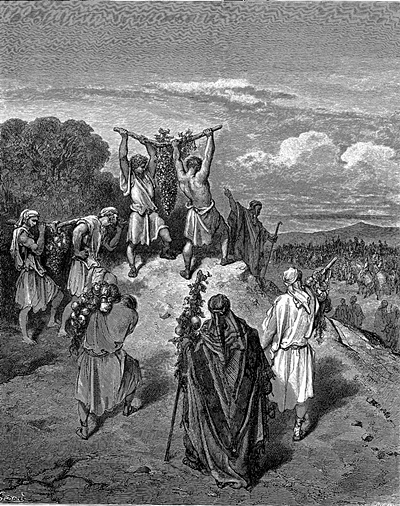
Return of the Spies – – Illustration by Gustav Dore (French artist, 1832-1883)
-
Conquest by Joshua (13th Century B.C.)
Hebron appears again in the accords of the conquest of the land of Israel by Joshua. In the campaign of the city of Gibeon, Joshua chased the 5 Amorite kings down to Azekah. (Joshua 10:5):
“Therefore the five kings of the Amorites, the king of Jerusalem, the king of Hebron, the king of Jarmuth, the king of Lachish, the king of Eglon, gathered themselves together, and went up, they and all their hosts, and encamped before Gibeon, and made war against it”.
The Israelites slew them, and God casted great hailstones which destroyed them.
Joshua 10 10-11: “And the LORD discomfited them before Israel, and slew them with a great slaughter at Gibeon, and chased them along the way that goeth up to Bethhoron, and smote them to Azekah, and unto Makkedah.
And it came to pass, as they fled from before Israel, and were in the going down to Bethhoron, that the LORD cast down great stones from heaven upon them unto Azekah, and they died: they were more which died with hailstones than they whom the children of Israel slew with the sword.”
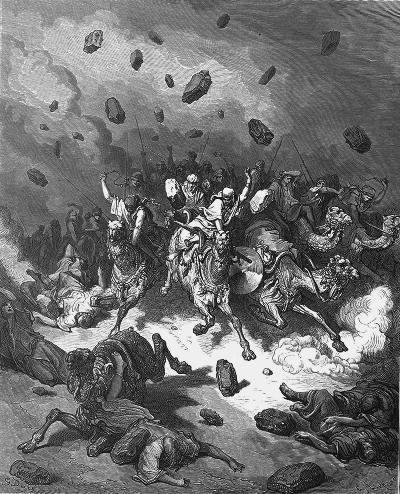
Hailstones on Amorites- Drawing by Gustav Dore (French artist, 1832-1883)
Joshua captures Hebron and kills all its people (Joshua 12: 36-37): “And Joshua went up from Eglon, and all Israel with him, unto Hebron; and they fought against it: And they took it, and smote it with the edge of the sword, and the king thereof, and all the cities thereof, and all the souls that were therein; he left none remaining, according to all that he had done to Eglon; but destroyed it utterly, and all the souls that were therein”.
The tribe of Judah receives the Canaanite city of Hebron after capturing it and killing the three giants, sons of Anak (Judges 1:10): “And Judah went against the Canaanites that dwelt in Hebron: (now the name of Hebron before was Kirjatharba:) and they slew Sheshai, and Ahiman, and Talmai”. The Israelite city received a special status of refugee city, one of five cities where some killers could flee to (Joshua 20:7): “And they appointed … Kirjatharba, which is Hebron, in the mountain of Judah”.
-
Iron Age II (1000 – 586 B.C.) – Israelite Kingdom
After David became king of Israel, he ruled in the city of Hebron (2 Samuel 2 :1-4): “And it came to pass after this, that David inquired of the LORD, saying, Shall I go up into any of the cities of Judah? And the LORD said unto him, Go up. And David said, Whither shall I go up? And he said, Unto Hebron. So David went up thither, and his two wives also, Ahinoam the Jezreelitess, and Abigail Nabal’s wife the Carmelite. And his men that were with him did David bring up, every man with his household: and they dwelt in the cities of Hebron. And the men of Judah came, and there they anointed David king over the house of Judah”.
David ruled in Hebron for seven years before moving to Jerusalem (2 Samuel 2:11): “And the time that David was king in Hebron over the house of Judah was seven years and six months”.
The last Biblical reference to Hebron was in conjunction with Absalom’s revolt against David (2 Samuel 15:7-10):
“And it came to pass after forty years, that Absalom said unto the king, I pray thee, let me go and pay my vow, which I have vowed unto the LORD, in Hebron.8 For thy servant vowed a vow while I abode at Geshur in Syria, saying, If the LORD shall bring me again indeed to Jerusalem, then I will serve the LORD. And the king said unto him, Go in peace. So he arose, and went to Hebron. But Absalom sent spies throughout all the tribes of Israel, saying, As soon as ye hear the sound of the trumpet, then ye shall say, Absalom reigneth in Hebron.”.
During the late 8th Century BC the area of Hebron and the Negev witnessed a growth of settlement activity, with dozens of new towns established. This growth decreased in the 7th Century following the Assyrian intrusions headed by Sennacherib (701 BC), and stopped at the end of the 6th Century following the Babylonian intrusion headed by Nebuchadnezzar (587 BC).
-
Assyrians (8th – 7th C BC):
The Assyrian empire, a rising force in the region, conquered the North Kingdom of Israel in 732BC, destroying most of the cities and villages in the land. The South Kingdom of Judah managed to survive this onslaught by teaming up with the Assyrians, but not for long. After the death of the Assyrian King Sargon II (722 705 BC), King Hezekiah mutinied against the Assyrians, joining other cities in the area who attempted to free themselves from the Assyrian conquest. Anticipating the coming Assyrian intrusion, he fortified Jerusalem and the major cities.
The Assyrian army came in 701, leaded by Sennacherib, son of Sargon II (2 Chronicles 32 1): “After these things, and the establishment thereof, Sennacherib king of Assyria came, and entered into Judah, and encamped against the fenced cities, and thought to win them for himself”.
According to an Assyrian clay tablet, Sennacherib conquered 46 cities in Judea, including Hebron, as found in the excavations of 1999 in the form of a layer of ash.
God spared Jerusalem from destruction and the Assyrians retreated (2 Chronicles 31 21-22): “And the LORD sent an angel, which cut off all the mighty men of valor, and the leaders and captains in the camp of the king of Assyria. So he returned with shame of face to his own land. And when he was come into the house of his god, they that came forth of his own bowels slew him there with the sword. Thus the LORD saved Hezekiah and the inhabitants of Jerusalem from the hand of Sennacherib the king of Assyria, and from the hand of all other, and guided them on every side”. The Assyrians retreated (2 Kings 19 36): “So Sennacherib king of Assyria departed, and went and returned, and dwelt at Nineveh”.
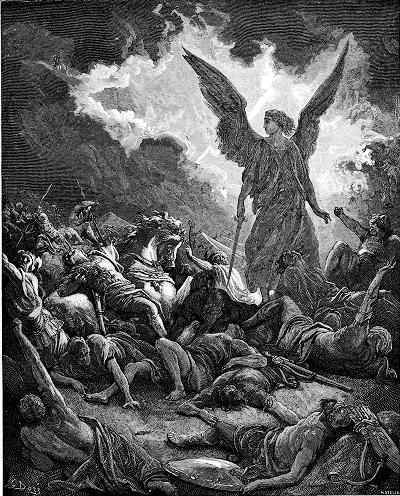
Sennacherib’s army destroyed by the angel, saving Jerusalem from the fate of Hebron and other Judean cities
– drawing by Gustav Dore (French artist, 1832-1883)
-
Babylonian and Persian (6th – 4th Century B.C.)
The Babylonian empire rose after the fall of the Assyrians (610 BC), defeated the Egyptians (609 BC) and conquered the land until the Nile (2 Kings 24 7): “… for the king of Babylon had taken from the river of Egypt unto the river Euphrates all that pertained to the king of Egypt”.
After two attempts of the Judean kings Jehoiakim and Zedekiah to disengage from the Babylonian conquest, Nebuchadnezzar II destroyed the Judah kingdom completely in 587 BC. In this intrusion (587) most of the cities were leveled, including Hebron.
The destruction of Judea brought the Idumeans from the south to occupy the region of Hebron, after they were driven out their country in Trans-Jordan by the Nabateans.
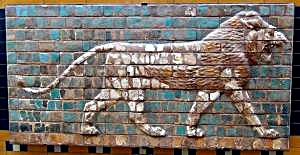
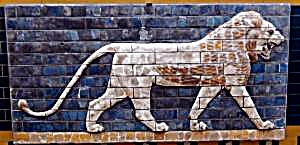
“Lions in Relief” – from the procession street in Babylon.
Nebuchadnezzar II period (604-562BC); glazed brick
[Istanbul Archaeological Museum]
In the Persian period (538 – 332 BC) the exiles from Babylon returned to Zion and resettled the city of Hebron in about 450 BC (Nehemiah 11:25): “…And for the villages, with their fields, some of the children of Judah dwelt at Kirjatharba, and in the villages thereof”.
-
Hellenistic and Hasmonean periods (4th Century – 1st Century BC)
During the Maccabee revolt, the Idumeans supported the Seleucids and helped them fight the Jews, although they resisted Hellenism. This caused the Maccabees, who founded the Hasmonean Kingdom, to wage war against the Idumeans. The area around Hebron was captured in 110 BC, by the Hasmonean King John Hyrcanus (reigned 134-104 BC), as part of his campaign against the Idumeans. Thus came the end of the Idumean control of the area, as promised by the prophecy (Obadiah 1, 19): “And they of the south shall possess the mount of Esau”.
The Idumeans were descendents of Esau, father of Edom and brother of Jacob, and had religious proximity to the Jews. Therefore, according to the historian Josephus Flavius and other historians of his times (Ptolemy and Strabo of Amesia), the Idumean cities and villages (an area around Hebron and Beersheba) were converted to Judaism by the Hasmoneans. (Antiquities 13 9:1): “Hyrcanus took also Dora and Marissa, cities of Idumea, and subdued all the Idumeans; and permitted them to stay in that country, if they would circumcise their genitals, and make use of the laws of the Jews; and they were so desirous of living in the country of their forefathers, that they submitted to the use of circumcision, and of the rest of the Jewish ways of living; at which time therefore this befell them, that they were hereafter no other than Jews”.
The conversion of the Idumeans increased the size of the Jewish population, and beefed up the Hasmonean army. Furthermore, Herod the Great was born in Idumea (74 BC), the second son of Antipater the Idumean (a powerful official who was appointed as the governor of Idumea by the Hasmoneans). Herod later became king of Judea under the Roman influence.
-
Roman and Byzantine periods (1st Century B.C. – 7th Century A.D.)
Herod the Great built a massive structure on top of the cave of the Patriarchs. He erected the building in honor of the Patriarchs, establishing a grand pilgrimage site. This building, 2,000 years old, is still standing and in service today, thus being the World’s oldest active public structure.
During the Roman period, Hebron was at the crossroad of a number of major roads. One road, connecting Jerusalem to Beersheba and the south, passed through a place called Er Rameh (see PEF map below, where a double dashed line depicts the ancient road). Other roads passed to Gaza, Beit Jibrin, Ashdod and other locations.
The road to Jerusalem appears on the Peutinger map (based on a 4th C Roman military road map, with an orientation of north on the right side). Jerusalem is marked by a pair of icons of a house with “Herusalem” above it. The location of Hebron, on the left side, is marked by us as a red square.
Peutinger Roman Military Map:
The road from Jerusalem to the south passed through Hebron
For more about Roman roads near Hebron, see the 19th Century PEF report (Volume II, sheet XXI, pp316-318).
During the Byzantine period, Hebron was a small village, but was considered as a holy place due to its historic burial place. The authorities converted the eastern part of the cave of the Patriarchs to a church.
-
Arab period (7th-11th C A.D.), Crusaders (12th-13th century)
After the Muslim conquest, the structure above the cave continued to function as a pilgrimage site, as Abraham and his sons are also holy to the Muslims. The building became a mosque. It was later reconverted to a church by the Crusaders (1100), and they named it San Abraham d ‘ Hebron.
The structure became a mosque again after the defeat of the Crusaders.
-
Muslim-Mongols-Mamelukes (13th-16th century)
In March 1260 the Mongols arrived from the far east, and captured the land, including Hebron. However, they were defeated by the Muslim Mameluke forces in September 1260 in the battle of Ein Jalut (Harod spring).
The Mamelukes were Turkish prisoners who were sold to the Sultan of Egypt, trained by him and served as his palace guards. In 1250 they seized the control of Egypt. The Mamlukes, headed by Baybars, captured Hebron from the Mongols in 1260. They changed the exterior of the building (1267), added minarets (prayer calling towers) over the outer wall, rooms in the interior, and inscribing Muslim inscriptions. Jews and Christians were forbidden, by an order of Bybars, to pass the seventh step on the eastern staircase. This ban continued for 700 years until Hebron was liberated in 1967 by Israel.
-
Ottoman Period (19th century)
Conder and Kitchener surveyed the area during the Survey of Western Palestine (SWP) in 1874. The report of modern Hebron and the ancient sites is found in sheet XXI.
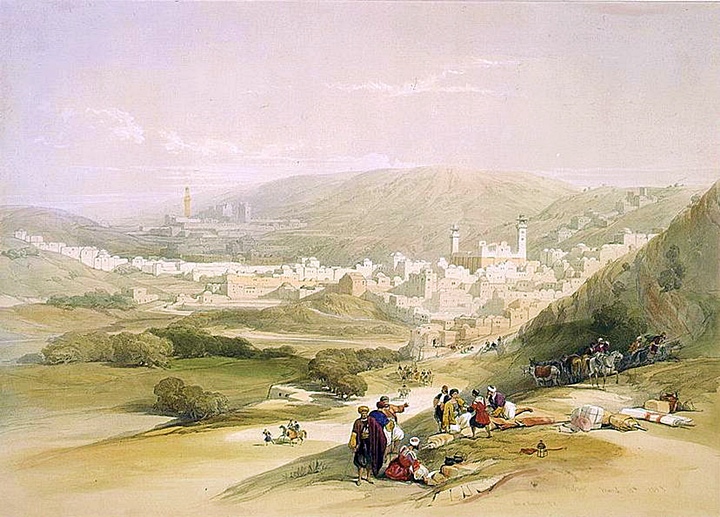
Library of Congress – Illustration of Hebron by Roberts, David, 1796-1864 , artist
Their report of the structure above the cave of the Patriarchs (called in Arabic: Abraham’s mosque, or: Al-Haram Al-Ibrahami , short form: Haram) is as follows (pp. 306-7):
“The most prominent object is the Haram enclosure, standing over the houses. The mosque within and the upper portion of the great enclosing wall were newly whitewashed in 1874, and presented a very dazzling appearance”. .. “There is a bazaar in the town north of the Haram ; on the hill above the town is a single house. The other prominent objects are the two minarets of the Haram, and that of the mosque of Sheikh ‘Aly Bukka. There is another mosque adjoining the Haram, on the north-cast, known as Jamia Ibn ‘ Othman, or el Jawalyeh. The hill above Hebron is terraced with stone walls and olive plantations. There is a ruined fortress on the north-west side of the Haram, and a Khan to the south, with an inscription, dating 670 A.H. (1280 A.D.) stating that it was erected by order of Kalawiin Seif ed Din, Sultan of Egypt. A school south of the Haram has over the door an inscription of the same Sultan, with the date 677 A.H.”.
An illustration of the Arab village, dated 1882, is shown here. This is from a book by CH. W. Wilson , one of the PEF explorers. The title reads: “Hebron”.
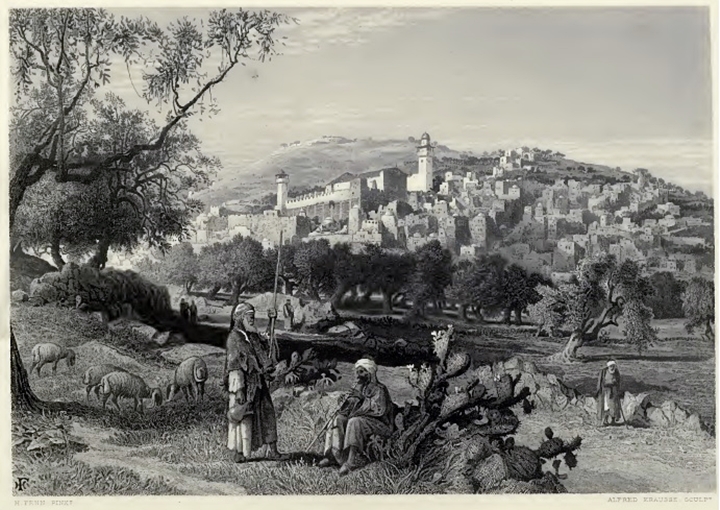
Ch. W. Wilson, Picturesque Palestine, 1882, Vol III P. 182
A photo from the Ottoman period is next, with the cave of Patriarchs in the center.
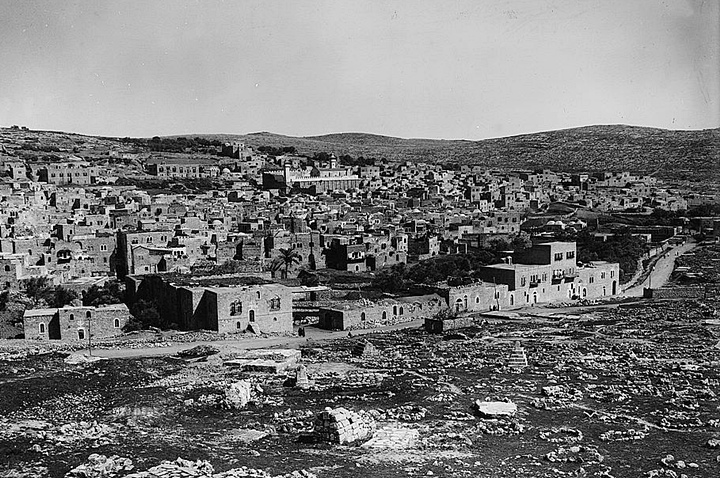
Library of Congress -Photo of Matson Collection, 1898
The PEF report of the location of Tel Hebron, the ruins of the Biblical city, includes the following (p. 308):
” It seems to have been supposed from an early period that ancient Hebron was not on the site of modern Hebron. The ‘Onomasticon’ makes the place near Drys (er Rameh). Hierosol gives this distance as 2 Roman miles. Sta. Paula (385 A.D.) visits the tombs of the Patriarchs, the oak, and then ‘ascends’ to Hebron. Theodorus (in sixth century) finds the oak 4 Roman miles from the Spelunca Duplex, or cavern of the Patriarchs, and this cavern 2 miles from Hebron. Arculphus (700 A.D. found the place in ruins, and west of the tombs of the Patriarchs. Saewulf (1102 A.D.) gives the same account, the tombs being in a strong castle and the town in ruins. Benjamin of Tudela (1163 A.D.) calls this castle St. Abraham, and speaks of the old city as on a hill and in ruins. Marino Sanuto (1321 A.D. places the old Hebron north of the cavern of Adam (‘Ain el Judeideh [=spring of the the dyke]), and north-west of Ebron Nova, in which he places the Spelunca Duplex. He also speaks of it as ‘ad dextram Mambre.’ The Oak or Terebinth of Abraham has been shown in two different sites. It seems probable, though not certain, that the present site is that shown from the twelfth century down”.
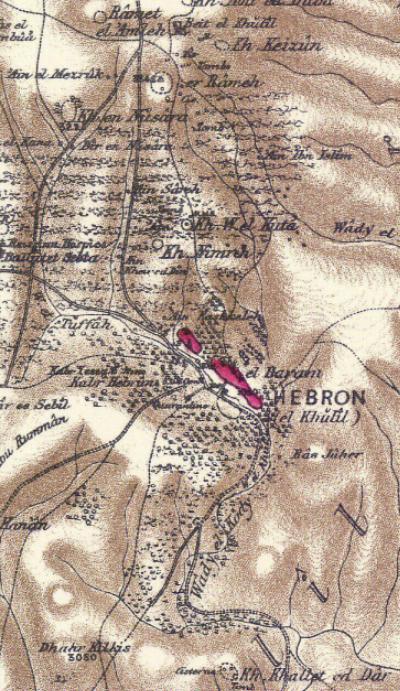
Part of map Sheet 21 of Survey of Western Palestine,
by Conder and Kitchener, 1872-1877.
(Published 1880, reprinted by LifeintheHolyLand.com)
- Modern Period
In August 1929, under the blind watch of the British mandate police, the Arab residents of Hebron massacred the small Jewish community in the city. These riots in Hebron, resulting in 67 dead and many wounded, then spread to the rest of the country, with 66 more dead. The Jewish community was reestablished in 1931, but another wave of terror of 1936 sealed the fate of Jewish Hebron.
The Jews returned to Hebron only following the six-day-war (1967), after the city returned to Israeli control. A new community – Kiryat Arba – was established in 1971 on the east side of Hebron. In 1979-1980 the Jewish presence in the heart of Hebron was reestablished following the reoccupation of Beit Hadassah.
Photos:
(a) Tomb of the Patriarchs
The massive structure, which was first constructed by Herod the Great 2,000 years ago, is built around the cave of the patriarchs. It is seen here from the southern side. The cave is now sealed off, and around it is the court (34m by 60m or 112 ft by 196 ft), which is surrounded by the 12m (39 ft) high walls. The width of the walls is 2m (6 ft). The corners of the walls are oriented to the south (as seen below), north, west and east.
Click on the photos to view in higher resolution…
The Herodian structure was roofless, and only during the Byzantine period a cover was added to the open courtyard.
The lower side of the walls are dated to Herod’s period, constructed of huge blocks. The largest block is 7.5m (24 ft) long by 1.5m (5 ft) high. The upper side of the walls are dated to the Muslim period.
On both sides of the structure are minarets – call-to-pray towers.
All photos below by Tuvia Liran.
- Arab section
The main entrance is on the south-east side, via the eastern staircase. This old photo shows the gate to the structure. This is where the Arabs enter to their sections of worships.
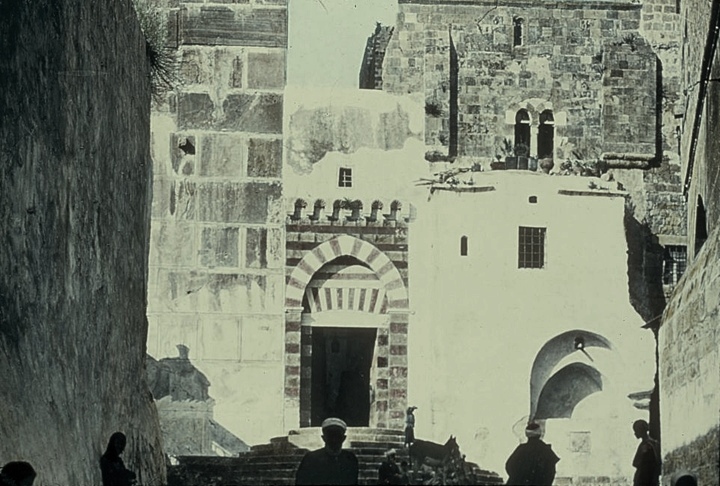
Library of Congress -Photo of Matson Collection, 1950
The only entrance to the cave of the Patriarchs is on the floor of the eastern side of the large prayer room. The entrance is sealed by a iron-grill cover.
A structure on the eastern wall is located over the sealed entrance, as seen on the right. The gracefully arched stone canopy is supported by four columns, is dated to the Mameluke period (built in 1423).
Through the opening on the floor (below), the clergymen lower oil lamps to the bottom of the cave.
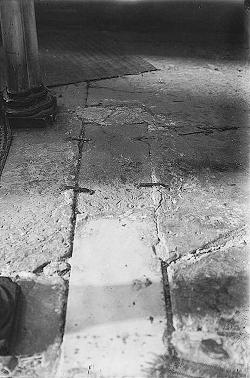
Library of Congress -Photo of American Colony, 1920
Opening to the cave, on the floor of the canopy
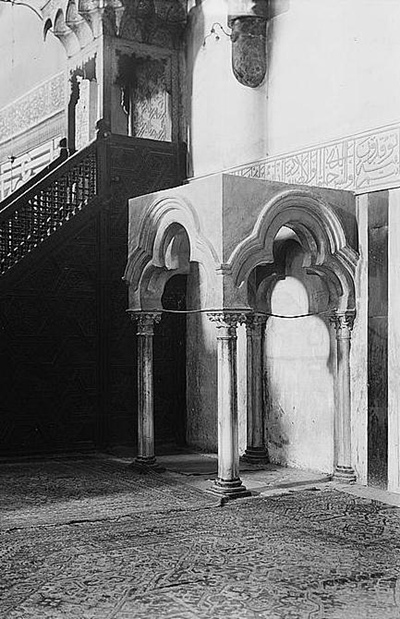
Library of Congress -Photo of American Colony, 1920
- Jewish section
The Jews are allowed to use only 20% of the total built area, while the Muslims use the other parts of the area. The entrance for the Jews is on the south western wall through a flight of stairs near the tomb of Joseph, and their synagogues are located on the western side of the courtyard.
Inside the structure are several halls. Its walls and columns are dated to the Byzantine period, while the Crusaders and Arabs added different elements. Most of the structures are dated to the 10th-11th Century, with some alternations made by the Mamelukes in the 15th century.
This photo shows the interior courtyard, where the central synagogue is located, near the entrance to Abraham’s and Sarah’s halls. Five synagogues in the site service hundreds of thousands of Jews come here for prayer and festivities every year.
- Abraham’s tomb
The entrance to the monument of Abraham is seen through the sealed window.
The monument tomb of Abraham is seen in the following old photo. The Arabic inscription reads “here is the tomb of the prophet Khalil”, where Khalil is the Arabic word for friend (Abraham is God’s friend).
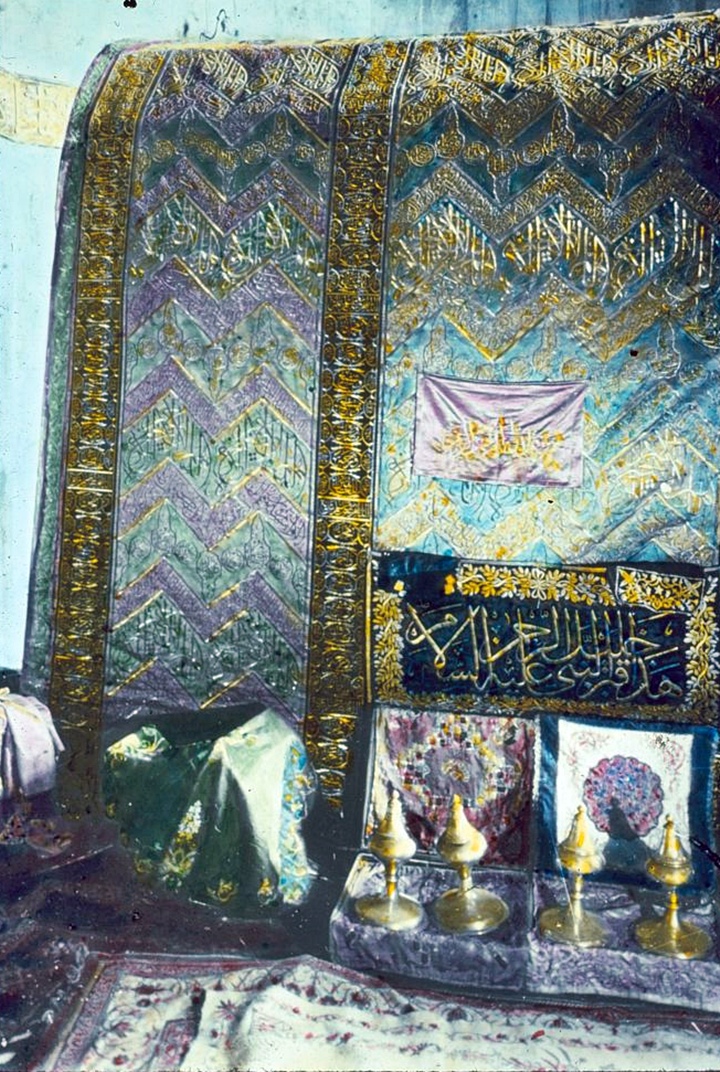
Library of Congress -Photo of Matson Collection, 1950
- Sarah
The next photo shows the entrance to the monument of Sarah .
A closer view of the monument of Sarah:
- Isaac and Rebecca
A synagogue in front of the halls of Isaac and Rebecca are seen in the next photo.
(b) Beit Hadassah
Beit Hadassah is a famous landmark in Hebron, as it was here where the re-establishment of the Jewish presence started in May 1979. A group of 10 women and 40 children entered to the first floor of the building, inside the Arab city of Hebron. Initially the government resisted this move, and allowed the renewal of the Jewish presence in April 1980 after terrorists murdered six Jews at the gate of the house.
This is a historic building: The first floor of this building, which is located in the heart of the old city of Hebron, was built as a Jewish charity institute in 1893. In 1911 a second story was built by the Hadassah organization. Hadassah, named after Esther’s Hebrew name (Esther 2:7), is a Jewish women medical organization. The organization built a clinic which served the Jewish and Arabic population. In the riots of 1929 all its inhabitants were murdered.
In 1948 the Jordanians, who occupied the city, converted it to a school. After the re-establishment of the Jewish quarter (1980), the structure and surrounding homes were repaired and returned back to the Jewish owners. Beit Hadassah was reconstructed in 1985, and resettled by Jewish families.
(c) Avraham Avinu neighborhood
The Jewish presence in the ancient Jewish quarter of southern Hebron (“Avraham Avinu” neighborhood, Hebrew for: Abraham our father) resumed in the late 1970s. Some of the old Jewish properties, confiscated by the Arabs following the riots of 1929 and the Jordan occupation of 1948, were reclaimed. This brought new friction, resulting in a need to separate the populations. Therefore, the Jewish presence was restricted to a single 1KM street according the Hebron accords of 1997. Along the street are closed Arab shops and sealed alleys that lead to the Arab section. This security measures protect the Jewish residents in the heart of the yet hostile Arab city.
The sign in the following photo explains that the stores were closed by the Israeli Defense Forces (IDF) for security reasons after the riots of year 2000.
(d) Tel Hebron
The ancient city of Hebron is located to the southwest of Beit Hadassah, on the edge of a a hill (Jebel Rumeida) overlooking the valley. The ruins cover an area of 15 acres, spread over the terraced hill. The name “Rumeida” is based on an Arabic name for ash, as many layers of ancient soil are found along the hillside.
Excavations in Tel Hebron were conducted by P. Hammond (1964-5), A. Ofer (1984-86) and salvage excavation by E. Eisenberg (1999). These excavations provided solid proofs that the ancient Canaanite city and royal city of David are located on this hill -Tell Rumeide. Significant remains unearthed by the excavations date to the Early Bronze, Middle Bronze, Late Bronze and Iron Age periods. The excavations also unearthed many findings of later periods – from the Israelite Kingdom to the Roman/Byzantine and early Arab periods.
A rare Canaanite tablet with hieroglyphics (scripts that are pictographic in form), dated to the times of the Patriarchs, was one of the interesting findings in the excavations.
Photo courtesy of Hebron Museum
The archaeologists identified several layers of successive cities of Canaanite Hebron. The ancient city of Hebron was fortified with massive walls, and traces of these walls of two different periods were discovered in the excavations.
The earliest fortifications date to the Early Bronze age (2600-2300 B.C.). These walls were more than 6m (20 feet) thick, consisting of large field stones. The walls rise 2.5m (8 ft) above the bedrock, and were the base of a higher mud brick wall. Two segments of this wall were excavated – on the south and north side of Tel Hebron. These fortifications attest to the importance of this city. A part of a staircase, leading to the city’s gate, was also uncovered.
The city was destroyed in 2600 B.C., then resettled in the Middle Bronze Age (1750-1650 B.C). The new walls of the Middle Bronze period city followed the earlier city walls. The stones used for constructing the walls were gigantic, earning the name “Cyclopean wall” (wall of the giants, named after the Biblical “Anak”s of Hebron). More interesting late Bronze age findings were found in a grave, dated to the time before the conquest by the Israelites.
A bowl illustrating gazelles, dated to the late Canaanite period, was also discovered in the excavations.
The source of water for the royal city was a spring called “Abraham’s spring” (‘Ain Judeideh [=spring of the the dyke]), a perennial spring on the lower eastern slope of the mound. The spring (PEF, VIII, p307) is located “in a vault, roof with masonry and reached by steps”.
Photo courtesy Museum of Eretz Yehuda, Kiryat Arba
Findings from the Israelite Iron age (following Joshua’s conquest) include storage pits, and a typical Israelite four-corner house dated to King Hezekiah. The fortifications of the Israelite Kingdom city continued to be based on the late Bronze walls and gates.
The city reached its peak during the late period of the Israelite Judean Kingdom. Evidence of the Assyrian conquest (701 B.C.) is also evident in the ash layer.
During the Hasmonean period, an area outside the walls was resettled, based on the findings of coins dated to Hasmonean King Alexander Janneus. During the uprising of the Jews against the Romans, two more layers were found dated to the Great revolt (67-70 A.D.) and Bar Kokhba revolt (132-135 A.D.). The Tel was repopulated during the Byzantine period, however the new city of Hebron moved to the valley below, and subsequently the Tel was abandoned, with olive trees covering the ruins of the “ash hill”.
Most of the excavation squares were covered by the Arab landowner, and so the ruins could not be seen on the hillside. Today, trails lead from the bottom of the valley where the old city of Hebron is located, up to the Tell Rumeide Jewish neighborhood. On the hill side stand ancient olive trees, as seen in the following photos:
A closer look at the magnificent bark of another tree:
A panoramic view from the top of the hill is seen here, with the city of Hebron in the background.
(e) City views from Tell Rumeide
The remains of the ruined Tel Hebron are located at the edge of the new Jewish neighborhood of Tell Rumeide.
A great panoramic view of southern Hebron is seen from an observation balcony.
From this point, a close up to some of the neighborhoods of Arab Hebron.
(f) “David’s pool”
This old photo shows an ancient pool located near the cave of the Patriarchs. The size of the pool is 40m by 40m (131 by 131 ft).
The Arabs call it the Sultan’s pool, and tradition relates it to David. The Bible tells about a pool where King David hangs the killers of Ishbosheth, son of King Saul (2 Samuel 4 12): “And David commanded his young men, and they slew them, and cut off their hands and their feet, and hanged them up over the pool in Hebron. But they took the head of Ishbosheth, and buried it in the sepulchre of Abner in Hebron”.
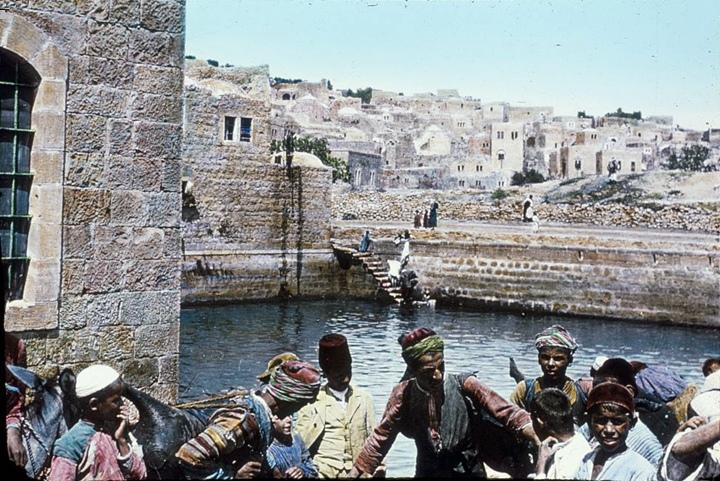
Library of Congress -Photo by Matson, 1950
The PEF report writes about this pool (Vol 3 Sheet XXI, p306): “A larger tank, opposite the main street to the Haram. It is 133 feet square and 21 feet deep, of good masonry, well cut, with a stone wall round it, and steps in the corners. It is called Birket es Sultan [=the Sultan’s house], and traditionally supposed to be the place where David hung the murderers o{ Ishbosheth.(2 Samuel iv. 12.) This tank is also filled by rain water. It is said to have been built by Sultan Kalawun”.
Etymology (behind the name):
* Names of Hebron:
-
Hebron – the name may be based on the Hebrew word Haver – friend, and Na’eh – pleasant, reference to Abraham. As per Isaiah, Abraham is God’s friend (Isaiah 41:8, also 2 Chronicles 20:7): “the seed of Abraham my friend”.
-
Al Khalil, El Khalil – Arabic name of the city, meaning: The friend (of God), a reference to Abraham.
-
Kiriath Arba – another name of Hebron, as per the Bible (Genesis 23 2): “And Sarah died in Kirjatharba; the same is Hebron in the land of Canaan”. The name means the city of Arba, who according to the Bible was the father of the Anakim (giants) (Joshua 14: 15): And the name of Hebron before was Kirjatharba; which Arba was a great man among the Anakims.”. Another reference (Joshua 15:13): “the city of Arba the father of Anak, which city is Hebron”.
Another source of the name can be traced to the Hebrew meaning – the city of four – which perhaps is named after the four giants (Anak and his three sons) or after the Biblical couples buried here (Patriarchs and Matriarchs, and Adam and Eve who are buried here as per the Jewish Zohar).
-
Kiryat Arba – a Jewish community east of the old city of Hebron (founded 1968).
* Names of Machpelah cave:
-
Machpelah – Hebrew for “multiplication”. This may be based on the structure of the caves – two adjoining cavities. Another source of the name may be based on the burial of couples – Patriarchs and Matriarchs.
Links:
* External:
-
Hebron fact sheet (pdf)
-
Who were the Nephilim and Sons of God? article about Anakim and Nephilim
-
Old photos of Hebron – Library of Congress collection
-
Dayan explores the cave of the Patriarchs Great article
-
Roman roads to Jerusalem (pdf)
-
Discovering Hebron (BAR 2005)
BibleWalks.com- Discover the Bible Land
Tel Arad<<<—previous site—<<< All Sites >>>— next Judea site—>>> Kesalon
This page was last updated on Feb 2, 2021 (new photo)
Sponsored links:
